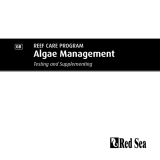
14 | Red Sea | Reef Care Program
Trace-Colors™ Iron+ Komplex aus 8 “Leicht”metallen
Hauptelemente Eisen, Mangan, Kobalt, Kupfer, Aluminum, Zink, Chrom und Nickel
Test für Dosierung Calcium oder Iron
Funktion
Essentielle Mikroelemente mit grundlegenden Rollen bei vielen biochemischen
Stoffwechselprozessen, darunter die Atmung und die Produktion von
Energie, Chlorophyll und photosynthetischer Katalysatoren.
Diese Elemente setzen sich im Korallenskelett ab, dieses dient
als Speicher für ihre Nutzung im Weichgewebe.
koralline Färbung C-Elemente sind mit den grünen und gelben Chromoproteinen (GFP) verbunden
Optimaler Gehalt 0,15 ppm Eisen gesamt (cheliert und nicht-cheliert) in einem künstlichen Riffaquarium
Überdosierung
Oberhalb der empfohlenen Menge giftig für alle Wirbellosen. Allgemeine Anzeichen
für eine Überdosierung sind die Verdunklung der Korallen infolge übermäßigen
Zooxanthellenwachstums und die starke Zunahme unerwünschter Algen.
Kann bei SPS-Korallen die Rückbildung des Weichgewebes verursachen.
Wechseln Sie im Falle einer Überdosierung 50% des Wassers
und reduzieren Sie die Dosis des Zusatzes um 50%.
Trace-Colors™
Bioactive Elements Komplex aus 18 Spurenelementen
Hauptelemente Silber, Gold, Vanadium und Wolfram
Test für Dosierung Calcium
Funktion Diese 18 Elemente (von allen Spurenelementen im natürlichen
Meerwasser) nehmen an verschiedenen Stoffwechselprozessen
innerhalb des korallinen Skeletts und Weichgewebes teil.
koralline Färbung D-Elemente sind mit blauen/violetten Chromoproteinen verbunden
(Pocciloporin), Diadinoxanthin und Dinoxanthin)
Überdosierung
Kann eine deutliche Rückbildung des korallinen Weichgewebes und Stress bei
Krustentieren verursachen. Allgemeines Anzeichen für eine Überdosierung
ist eine Verdunklung der Korallen. Wechseln Sie im Falle einer Überdosierung
50 % des Wassers und reduzieren Sie die Dosis des Zusatzes um 50%.
























